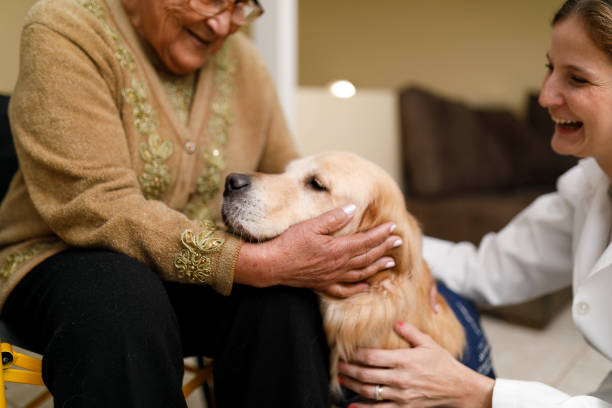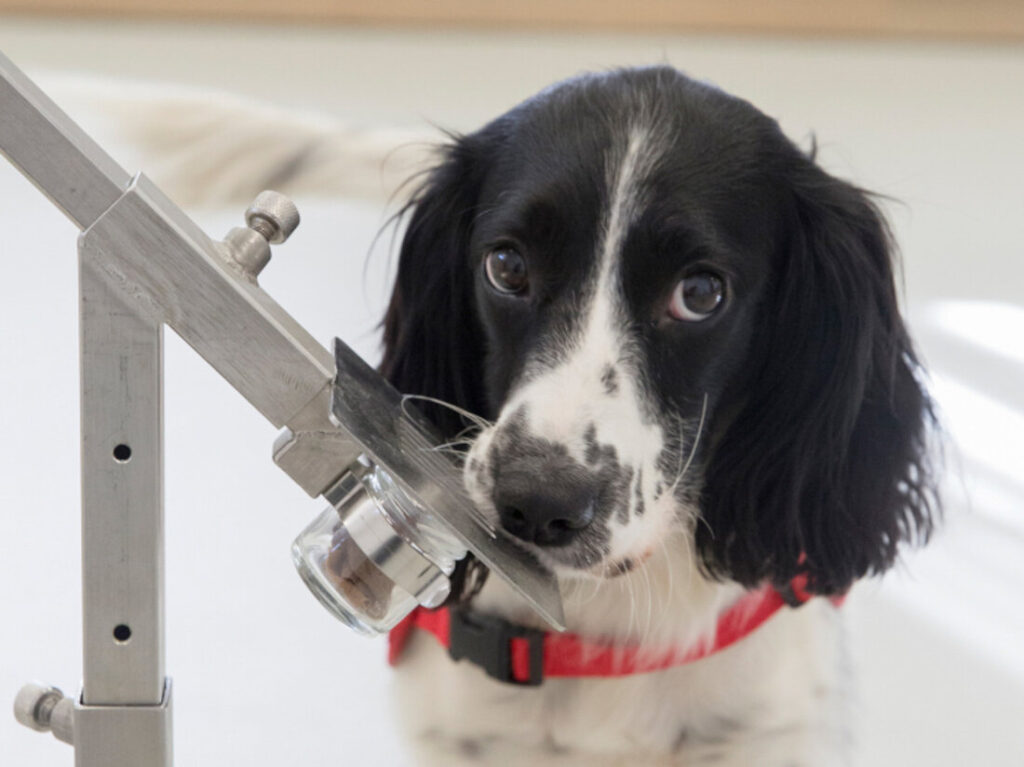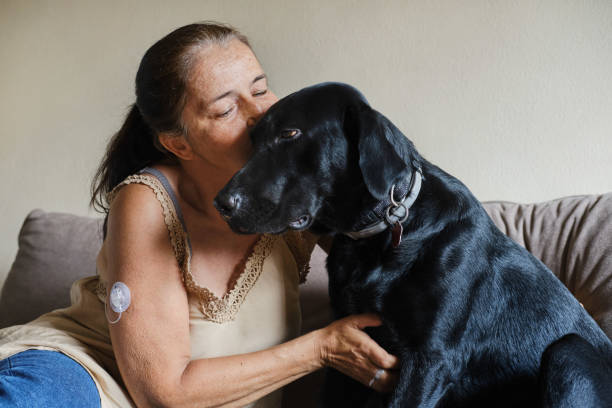Dogs aren’t just man’s best friend—they’re miracle workers with noses that can detect illnesses, conditions, and life-threatening events long before we even know something’s wrong. Their superpowered sniffers, packed with up to 300 million scent receptors, pick up on changes in our bodies that we can’t smell ourselves. From cancer to migraines, dogs are saving lives one sniff at a time. Here are 15 fascinating diseases and conditions that dogs can smell in humans—and how they’re reshaping medicine as we know it.
1. Cancer

YouTube
Studies show dogs can detect cancer with up to 97% accuracy. In one remarkable case, a dog detected over 500 cancer cases, including early-stage breast, lung, and prostate cancers. Trained dogs identify volatile organic compounds (VOCs) released by cancer cells in breath, sweat, or urine—sometimes years before symptoms develop. In trials, dogs have even outperformed traditional diagnostic tools. Their uncanny ability to sniff out cancer is changing how we approach early detection, potentially saving thousands of lives.
2. Diabetes

Diabetic alert dogs are trained to detect changes in blood sugar levels with over 90% accuracy. One study found they can sense hypoglycemia 20 minutes before a glucose monitor does. In one case, a dog saved its owner by waking them during the night when their blood sugar dropped dangerously low. These dogs use their noses to detect chemical shifts in sweat and breath, acting as early-warning systems. Their interventions have prevented countless diabetic emergencies, proving their instincts are life-saving.
3. COVID-19

During the COVID-19 pandemic, detection dogs identified infections with an impressive 94% accuracy. In trials, they successfully detected the virus in asymptomatic patients and outperformed some rapid tests. One airport program found dogs could screen 300 passengers in under an hour—a speed no machine can match. By sniffing sweat samples, these pandemic heroes offered a quick, non-invasive way to prevent outbreaks. Their groundbreaking work is paving the way for using dogs in future global health crises.
4. Epileptic Seizures

Seizure-alert dogs detect oncoming episodes with up to 80% accuracy, often 10-30 minutes in advance. One study showed dogs can smell changes in cortisol levels released before a seizure. In one heartwarming case, a dog alerted its owner by barking and pacing, giving them time to get to safety. These warnings allow people with epilepsy to avoid injuries and find help, proving these dogs are more than companions—they’re protectors.
5. Parkinson’s Disease

Dogs trained to detect Parkinson’s disease can identify it up to 10 years before symptoms appear. In a recent trial, dogs had a 90% success rate in distinguishing Parkinson’s patients from healthy individuals. The disease alters skin oils, releasing a specific scent that dogs pick up. Early detection could slow progression, and researchers are working on replicating dogs’ abilities in diagnostic tools. Their noses are giving hope to thousands battling this degenerative disease.
6. Malaria

In field trials, dogs detected malaria in sweat samples with 70% accuracy, even in asymptomatic individuals. Malaria emits a unique odor caused by parasites, and dogs can sniff it out faster than most diagnostic methods. In Africa, where early detection is critical, dogs are transforming disease control efforts. Their ability to identify cases in seconds, even in remote areas, is saving countless lives and revolutionizing how we combat this global health threat.
7. PTSD Protectors

Studies show PTSD service dogs reduce anxiety and flashbacks in 82% of trauma survivors. These dogs are trained to detect rising cortisol levels and intervene with calming techniques like leaning against their owner or waking them from nightmares. One veteran credits their dog for saving their life by interrupting flashbacks and creating a barrier in crowded spaces. For those coping with trauma, these dogs offer safety, stability, and emotional healing in ways no medication can match.
8. Migraines

YouTube
Dogs can sense migraines up to two hours before they strike, giving sufferers time to take medication and avoid debilitating pain. In one study, over 60% of migraine sufferers reported their dogs alerted them to an attack through clingy or unusual behavior. These canines are believed to detect changes in blood flow or hormone levels that precede migraines. Their intuitive warnings offer relief and control, proving their instincts are more effective than a prescription.
9. Heart Attack

Dogs have been shown to detect heart attacks by sniffing changes in sweat and breath caused by rising potassium levels. In one case, a dog barked persistently at its owner minutes before they suffered a cardiac event, giving them time to call for help. Studies suggest dogs can sense subtle changes in body chemistry associated with heart distress. These life-saving instincts turn potential tragedies into survival stories, showcasing the incredible bond between humans and their dogs.
10. Narcolepsy

Narcolepsy-alert dogs are trained to detect body chemistry changes that precede sudden sleep attacks. In one case, a dog warned its owner by nudging them to sit down just before they collapsed. These dogs provide independence and safety by preventing injuries caused by unexpected episodes. Researchers believe they pick up on shifts in brain activity or muscle tone, offering their owners the freedom to live with confidence despite their condition.
11. Stress and Anxiety

Research shows dogs can detect stress hormones like cortisol within minutes, and emotional support dogs reduce anxiety in 84% of their owners. In one instance, a dog pressed against its owner during a panic attack, calming them before it escalated. These intuitive animals sense their human emotions and provide grounding techniques like leaning or nudging. Their ability to act as emotional anchors proves they’re not just pets—they’re healers.
12. Infections

Dogs trained to detect infections like C. difficile can identify bacteria in patient samples with over 90% accuracy. One dog detected an infection in a hospital patient before symptoms appeared, allowing doctors to intervene early. These canines pick up on odors released by bacteria, often outperforming lab tests in speed and precision. Their incredible noses are reshaping how we detect and treat dangerous infections in healthcare settings.
13. Low Blood Pressure

Dogs trained to detect drops in blood pressure have saved countless lives by warning their owners before fainting spells. In one case, a dog barked and nudged its owner to sit down moments before they collapsed. These dogs detect changes in body chemistry that signal low blood pressure, giving their humans time to avoid falls or injuries. Their instincts are sharper than any monitor, providing a critical safety net for those at risk.
14. Tuberculosis

YouTube
In trials, dogs detected tuberculosis in patient samples with up to 86% accuracy, even when lab tests failed. TB releases a distinct odor that dogs can identify in seconds, making them invaluable in rural areas where early detection is critical. Their work is revolutionizing diagnostics in underserved communities, offering a cost-effective and life-saving alternative to traditional methods. These dogs are unsung heroes in the fight against infectious diseases.
15. Addison’s Disease

Dogs can detect adrenal crises caused by Addison’s disease, giving their owners time to seek emergency care. In one documented case, a dog barked persistently until their owner took action, avoiding a potentially fatal episode. Addison’s alert dogs are trained to sense hormonal imbalances and react before symptoms like fainting or fatigue occur. Their instincts are often the difference between life and death for those with this rare condition.
16. Depression

Studies show dogs reduce depression symptoms in their owners by 74%. By detecting hormonal shifts linked to sadness, these intuitive animals respond with comforting gestures like staying close or nudging their humans. One woman credits her dog for pulling her out of the darkest moments with its quiet presence. These dogs don’t just provide emotional support—they bring light and hope when it’s needed most.
17. Ovarian Cancer

YouTube
Ovarian cancer, known as the “silent killer,” is notoriously hard to detect. In one study, dogs identified the disease in breath samples with up to 98% accuracy. A woman’s dog saved her life by alerting her to the presence of cancer before she had symptoms. By sniffing out the unique compounds released by cancer cells, these dogs offer hope for earlier diagnoses and better outcomes.
18. Allergies

Allergy-alert dogs can detect allergens like peanuts with over 90% accuracy. In one case, a dog saved a child’s life by sniffing out traces of peanuts in a snack, preventing a severe reaction. These dogs provide peace of mind to families living with life-threatening allergies, acting as a barrier between their humans and hidden dangers. Their incredible noses turn everyday moments into safer, stress-free experiences.
Dogs’ ability to detect illnesses and save lives is nothing short of miraculous. These 18 stories show how their instincts and training are transforming healthcare and offering hope. From deadly diseases to emotional struggles, dogs prove time and again that they’re more than companions—they’re heroes. Could your dog save your life? You might already have a miracle worker at your feet.


